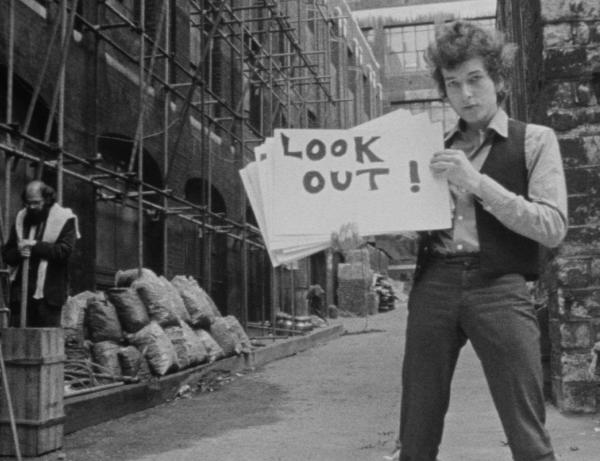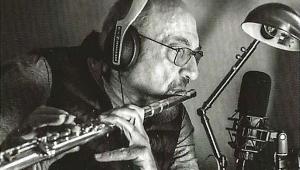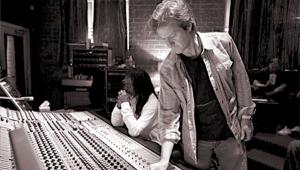D.A. Pennebaker on 50 Years of Bob Dylan: Dont Look Back, Part I

It’s beyond understatement to say Dont Look Back (apostrophe very deliberately missing; more on that later) set the bar for rock and pop-culture documentaries, a style that’s still very much followed today. “That’s the way it’s all done now,” Pennebaker agrees. “In that hotel room, there was nobody with me to take sound, so I just stuck the recorder in the middle of the room and turned it on, and I just hoped for the best. Now, everybody wants to get a piece of the action. Sometimes it works, sometimes it doesn’t. Everybody learns from it.”
It seems almost too easy to think that’s how the pure narrative of Dont Look Back emerged, given today’s uber-ubiquitous selfie-centric society, but the concept of shooting reality anything was simply not the norm a half-century ago. But thanks to the level of trust Dylan granted Pennebaker on that myth-making May 1965 tour, Dont Look Back, which first hit theaters in May 1967, shows the folk poet creating the legend in real time while being very much entrenched in his element: sometimes relaxed and playful, other times mischievous and challenging, and always absolutely riveting onstage during performance. “I think it interested him that I paid so much attention to him,” Pennebaker theorizes. “I filmed a lot of songs just by myself; a lot of the concerts. I filmed bits of the songs, but I recorded all of the songs, so we have audio for all of them.”
To celebrate the documentary’s golden anniversary, The Criterion Collection has done it again with a director-approved special edition that contains a restored 4K transfer, as well as restored monaural sound taken from Pennebaker’s original quarter-inch magnetic masters, presented uncompressed on Blu-ray. In addition to carrying over bonus material from previous releases, new extras — such as an evaluation of the evolution of Pennebaker’s lensing style, D.A. and onetime Dylan tour manager/compatriot Bob Neuwirth analyzing why they worked together so well on this and other tours, and Patti Smith talking about how the film influenced her both personally and professionally — all make this one of the best historical Blu-ray offerings, well, ever.
And because Pennebaker was a veritable fount of fascinating information about Dont Look Back and his own pioneering in-the-moment documentary-filming techniques, we’re going to present this interview in two parts. Here in Part I, D.A. and I discuss how he gained Dylan’s trust, the way he predicted the selfie culture, and why he had to get on his back to shoot certain live performances. Then, in Part II, we will delve further into the visual minutiae and also get into the audio side of things, not to mention dissecting the origin of the film’s legendary opening cue-card sequence. Give the anarchist a cigarette — D.A. is actually out of the basement, but still mixing up the medicine.
Mike Mettler: OK, D.A., we will have to look back, despite the title. For one thing, I’ve been enjoying the new bonus material on the Blu-ray. I especially like how you and Bob Neuwirth talk about the 1967 New York Times review where the writer [Donal J. Henahan, on September 7, 1967] says, “It will be a good joke on us all if, in fifty years or so, Dylan is regarded as a significant figure in English poetry.” Interesting how that all turned out, right?
D.A. Pennebaker: Well, that’s true. That was always interesting about him. (chuckles)
Mettler: While you were working on the film, you must have felt the weight of how significant that English tour was for him in many ways.
Pennebaker: I was intrigued by it. It was surprising to me, because most of the people at the concert we shot at the theater in London [at the Royal Albert Hall, May 9-10, 1965] — they were so unlike the American audience he had. They were older and much more mature, and really interested in the poetics of what he was doing, rather than just the celebrity of it.
Mettler: You guys also said Dylan fit in much more with the English traditions of folk because of their history, so they were more ready to embrace the style of what he was doing.
Pennebaker: Yeah, well, for them, he was like the early version of Keats or Shelley. He used language in the kind of original way that always catches your ear when you hear it. You kind of wonder, “What did he say??” (chuckles)
Mettler: Is there any one particular lyric that was the lightbulb line for you, the one that made you go, “I’ve gotta follow this guy”?
Pennebaker: There are a couple of things that he did, both speaking normally, and in a song. There’s one phrase that particularly struck me: “She’s true, like ice, like fire” [a line from “Love Minus Zero/No Limit,” from March 1965’s Bringing It All Back Home]. Just the whole way it was worded. That just struck me as an original piece of language.
Mettler: In terms of the picture restoration, the film looks so good on the new Criterion Collection Blu-ray. As a visual person, how do you feel about it 50 years later after you shot it? How does it look to your eye today?
Pennebaker: It’s very good, isn’t it? Well, it looks beautiful. I had to do it in black and white because there was no color then; color came in 2 years later. And it was very risky, because I was using an English lab – and luckily, it was a very good lab.
I was pushing all of the material, because I would load a magazine, and then we would shoot half of it in the hotel, and then the next day we would be outside shooting the other half, so I had to fix one speed for all of the film — everything. It was a push stop; two stops. And I didn’t use any lights at all; I didn’t have any. I used whatever it was in the room, or outside, or in the car. Like I said, you felt it was all a little risky (chuckles), but it depended on the labs.
The original stuff was good, but then I had to make a 35 [mm] blow-up, and that took a while. Some of the film got damaged and it was cut kind of hard, because I was trying to do it inexpensively, which was maybe a mistake. But we had to distribute it ourselves, because we didn’t have a distributor. We ran it in a porn theater out in San Francisco [the Presidio Theater, May 16, 1967]. We had a 16 [mm] print that ran there for almost a year, just that print. There wasn’t enough money for us to get a 35 [mm] blowup for when we opened up in New York.
Mettler: Right, at the 34th Street East Theater [in September 1967]. Do you think Dont Look Back could have worked in color? I think the black and white makes much more sense.
Pennebaker: No, I liked the black and white, and I was used to it, so I didn’t even think about color. Two years later, I did do a color film with Bob, and that was interesting too, but it was quite different.
Mettler: Yeah, some of that stuff from the European tour was part of the extras, the stuff somebody else directed — well, he directed, I mean.
Pennebaker: Dylan got in the middle of trying to make a film out of it, but he was not — it’s really hard for somebody who’s good at something else to concentrate totally for a long period of time on making a film. It’s not easy. So that film, which was called Eat the Document [shot in Europe in 1966], hasn’t really survived. But it’s interesting. Some of the footage was fantastic. Marty [i.e., Martin Scorsese], did pick up on some of it, and he made a film out of it. Not all of it; some of it.
Mettler: Yeah, he used some of that footage in No Direction Home (2005).
Pennebaker: Right. At the time we shot it, I thought it was too bad, because that footage is just going to end up in a box somewhere. I didn’t know what to do with it because Dylan said, “You’ve got your film, and now I want to make one myself.” That was a situation where I wasn’t interested in fighting about the film. It didn’t seem to be worth it.
Mettler: It’s all historical footage, especially at this point, so I hope it gets released someday.
Pennebaker: Oh yeah, yeah. Eventually, it will see the light of day. Eventually, everybody knows everything. (both laugh) I don’t think it’s lost. Some of the performance stuff is really quite interesting, and so different from the black and white. I actually made a lens myself, a wide-angle lens to use on the camera [done by modifying an old Switar lens and putting a big reduction glass in front, and shooting with Kodak Ektrachrome 7242 film]. I got on the stage with him. Some of that stuff is quite different, and not anything you could do in black and white.
Mettler: That’s when we see him playing “Ballad of a Thin Man” [from August 1965's Highway 61 Revisited] at the piano in one of the extras, and you’re right there practically in his face, where we see that halo effect on him. He’s out there with a full band at that point [the Hawks, who’d later be known as The Band].
Pennebaker: Yeah, yeah. The idea of being with a band, he felt protected. By himself, he’d gotten kind of lonely, I think.
When they were editing it, he and Robbie [Robertson, of the Hawks/The Band] were sort of arguing over which shot to use — this shot, or a shot of Robbie playing guitar. He kind of fell out with Robbie over that.
Performers often don’t know what a film is, because, in a sense, they think what they’re doing is somehow happening on another planet. And the film is a separate thing. By the time it gets to editing the film, they’re on to doing something else.
Mettler: You say it very well in the commentary and some of the other interviews I’ve seen you do — you’re there watching. And you’re better at watching and observing.
Pennebaker: Right, and they’re not watching — they’re playing.
Mettler: Yes, and your job as the filmmaker, director, and editor is to get the truth.
Pennebaker: This is a new kind of film. There were no rules at that point, and it was like a new adventure — and for me, particularly, because I was making the film all by myself.
Mettler: You had a certain empathy, when you were filming — is that the right word for it?
Pennebaker: Yeah, it is. It was like doing something for the first time, so no one was quite sure how to do it.
Mettler: Is shooting widescreen freeing to you, or just a different animal?
Pennebaker: I’m looking at everything through a camera, and I’ve got a zoom lens that can make the screen larger or smaller, so I can kind of do that within the camera, and make my decisions as I watch it. The wider screen and the wider image — it’s something you adapt to rather quickly. It gives you the possibility of having two things going on at the same time, where with the smaller screen, you pretty much concentrated on what was in the middle.
Mettler: And you’re a pioneer in using the zoom lens, which hadn’t been used a whole lot at that point.
Pennebaker: You had to, because there was no way you were going to be able to change lenses while you were shooting.
Mettler: You created a number of cameras on your own, out of necessity.
Pennebaker: We had to build it to get a sync sound camera, because there was no sync camera you could carry around. That’s what we had to build.
Mettler: And now everyone in the universe can just pull out a phone and start filming. Does that seem “right” to you?
Pennebaker: I sort of imagined that would happen. There’s such a difference between these incredibly arranged and directed films that you see in the movie houses that come from Hollywood to what you do in your own house or your backyard. I always thought that was just as interesting to people — it just needs to be technically proficient. And when it was, then everybody took to it.
I think they work best when the filmmaker is actually exploring, and they’re using the camera as a device for exploring. It tends to be the most interesting. People have different ways of doing it, and sometimes it surprises you. It’s like animation. It’s showing something that’s not alive, but sometimes, it becomes very life-like. And that’s always a surprise.
And I like the idea that these films can surprise you. Most of the time, the scripted film really doesn’t surprise you. It becomes a theatrical concept, totally. That in itself, when it’s good, is fantastic, but it’s also very defining. It doesn’t allow for much error or mistake. And the home movie can allow for a lot of things to go wrong, and still work.
Mettler: One thing one of your cameramen, Jim Desmond, says is that it’s a matter of trust, so that you can get those honest, exploratory moments. How did you feel you were able to establish trust with “Mr. D,” as you’ve called him?
Pennebaker: I think he didn’t think much about it. I was part of the people who were around him. We didn’t set up stuff for the camera. We didn’t set up lights; we didn’t have tripods or any of the “normal” equipment that accompanies the filming process. So I think he thought it was kind of a throwaway.
Mettler: You weren’t intrusive.
Pennebaker: He didn’t think it was very serious, but he could tell what I was doing, because he could see me in the concert hall, particularly because I would be pretty close to where he was. When we did the one about the woman who got killed by the cane —
Mettler: Yeah, “The Lonesome Death of Hattie Carroll” [from January 1964’s The Times They Are a-Changin’].
Pennebaker: — in order to film that, I had to lie down in the aisle between the seats and look up at him. I couldn’t stand there in the middle of it, so I’d lay down on my back and film the whole thing from that position. That made me get a very good shot of his head, and I really wanted just to see him really close up, singing that song.
Mettler: It’s so powerful, and we as viewers feel we’ve earned being able to be that close when we get to that part of the film.
Pennebaker: And usually, when you hear a person singing at a concert, you want to see them up close. When we saw a film of him playing in Germany, they had one of those big blow-up screens behind him. They had very close head shots of him during the thing so the whole audience could see, and that was what I was trying to get on the film.
I could see that really worked for people, because they really weren’t interested in the rest of the scene. It wasn’t like they were watching a complicated thing taking place somewhere they didn’t know — they were watching the person sing, and they wanted to watch him as close as they could. And that’s what this kind of filming can do.
See you back here on Friday, November 27, for Part II!





























































